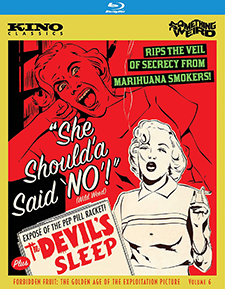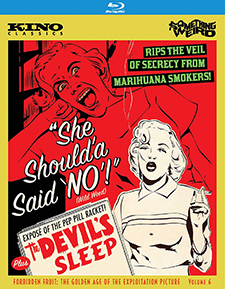She Should'a Said No! & The Devil’s Sleep (Blu-ray Review)

Director
Sam Newell/W. Merle ConnellRelease Date(s)
1949 (August 18, 2020)Studio(s)
Modern Film Distributors/Screen Classics/Something Weird Video (Kino Classics)- Film/Program Grade: See Below
- Video Grade: See Below
- Audio Grade: See Below
- Extras Grade: B
- Overall Grade: C+
Review
Made at a time when mainstream Hollywood steered clear of the controversial and disturbing subject of drug addiction, the independent films She Should’a Said No! and The Devil’s Sleep (both released in 1949) relied on exaggeration and fear to show that smoking marijuana and taking pills illegally is only the beginning of a life of crime and despair.
In 1948, starlet Lila Leeds was arrested along with Robert Mitchum on charges of marijuana possession. Both served 60 days in jail. Though Mitchum’s career survived the scandal, Leeds’ was practically destroyed until she was offered the starring role in She Should’a Said No! (also known as Wild Weed). Leeds plays Anne Lester, a chorus girl trying to pay for her young brother’s college education. After meeting dope pusher Marky (Alan Baxter), she’s drawn into a world of marijuana smoking, which leads to tragedy and her realization that getting high has terrible consequences.
She Should’a Said No! is exploitative in amplifying the effects of social pot smoking. Unsavory characters, immorality, prison, and suicide will follow, according to the film. This low-budget picture was designed to titillate audiences while posing as a cautionary tale to protect young people from marijuana’s inevitable moral decay. Based more on scare tactics than on scientific facts, it uses the police procedural format to tell its sensationalist story.
The acting is weak, the screenplay is overly melodramatic, and there is a preachy quality throughout, as if to hit us over the head to make sure we get the message to stay away from weed. Leeds does her best with weak material. Baxter is appropriately smarmy as the arrogant drug dealer. David Holt, as Anne’s brother, marks a new low for inept screen acting (he also looks far too old to be a college student). Lyle Talbot turns in his typically rigid performance as the cop who recruits Anne to bring Marky down.
The second film, The Devil’s Sleep (aka Hopped Up), centers on the illegal use of prescription pills. Drug kingpin Umberto Scalli (Timothy Farrell) uses a women’s health spa as a front for his “diet” pill racket. Judge Rosalind Ballantine (Lita Grey Chaplin) wants to nail Scalli, but her daughter (Tracy Lynne) is set up and the pushers blackmail the judge by showing her a photo of her naked daughter.
This is a truly awful film, from its wooden performances, dull photography, awkward pauses, and preposterous characters to its non-existent production design. Everything looks cheap. In the previous film, there’s an attempt at a few noir touches. In The Devil’s Sleep, no one, least of all director W. Merle Connell, seems to care. What the director does care about is showing as much female flesh as he can get away with. At a time when Hollywood was still timid about nudity, Connell amps up the bare skin. For no apparent reason, Mr. America George Eiferman pops up in the latter half of the film as as a spa instructor… and his muscles are far more developed than his acting ability.
The only bright spot in this dreary picture is a comic scene featuring Mildred Davis as Tessie T. Tessy, a large woman who enrolls at the spa to lose weight. A very funny comedienne, she does a Who’s on First? type of routine with various spa employees about her unusual name. This has nothing to do with the plot, but it’s a welcome reward for struggling through this pot boiler.
Featuring 1080p resolution, both films are presented in the aspect ratio of 1.33:1 by Kino Classics. The picture quality is below average with extensive scratches, sprocket damage, jump cuts, and emulsion fogging visible throughout. The photography is perfunctory and suggests a fast shooting schedule with little time to create interesting shadows and atmospheric lighting. The visuals look flat. In She Should’a Said No!, a montage suggests a drug hallucination, but that’s as creative as the visuals get. The Devil’s Sleep has lengthy vertical scratches on both left and right sides of the frame and emulsion marks. It, too, is unimaginatively shot, with master shots making up entire scenes, with little coverage. Actors are typically stationary, standing or sitting, and the lack of movement makes the film look like a filmed play—a bad one at that. The “kids” are actors far older than they are playing, destroying any semblance of credibility.
The soundtrack is English 2.0 Mono DTS-High Definition Master Audio. Optional subtitles in English SDH are available. The dialogue in She Should’a Said No! is clear, and there is a lot of loud, exaggerated laughter to indicate that the smokers are high. Whenever characters smoke marijuana, an eerie theremin score accompanies the visuals. In The Devil’s Sleep, the dialogue is clipped, wooden, and amateurish—almost as if the “actors” are spending all their energy remembering their lines. Music is absent except for a few scenes late in the film, and sounds as if it was drawn from the public domain.
SHE SHOULD’A SAID NO! (FILM/VIDEO/AUDIO): C/B/B-
THE DEVIL’S SLEEP (FILM/VIDEO/AUDIO): D/D/C-
Bonus materials include an audio commentary and five trailers.
Audio Commentary – The audio commentary for She Should’a Said No! features film historian and critic Alexandra Heller-Nicholas who discusses at length the 1948 drug bust involving Lila Leeds and Robert Mitchum that forms the basis of this semi-autobiographical film. The arrest amplified Mitchum’s “bad boy” image. Leeds, 20 at the time, was “reduced for the value of her looks.” She had had small parts in Green Dolphin Street and Lady in the Lake before her arrest, which made her famous. She and Mitchum both spent 60 days in jail. The producers told Leeds that She Should’a Said No! would do others good and serve as a deterrent to smoking marijuana, but she wasn’t happy with the final film and its exploitative marketing. The film took only 6 days to shoot, yet is fairly polished in comparison to other exploitation films made at the time. The cinematography by Jack Greenhalgh looks impressive despite the film’s low budget and tight shooting schedule. Lila Leeds came from a religious family in a small Kansas town. She moved to Los Angeles and was introduced to marijuana by musicians in Stan Kenton’s orchestra. She joined a small theater company, was noticed there by a talent scout, and was signed to an MGM contract. Audiences already associated Lila Leeds with depravity and scandal when the film was originally released. It played on TV in the 1950s and the midnight theatrical circuit in the 1960s. It was also shown under the title Confessions of Lila Leeds. A court case involving the film ended censorship in Pennsylvania. This started a domino effect of other states’ censorship boards disbanding. The movie Production Code gave way to the Motion Picture Association of America’s rating system, initiated in 1968. After making the film, Leeds had a rough life. There were incidents of public intoxication, car accidents, custody battles for her children, stints in rehab, and repeated relapses into heroin. She spoke about writing a book but never did, though a few books were written about her. In 1955, she testified before a Senate subcommittee that her career had been ruined by marijuana and heroin. In 1956, she was arrested in Chicago for soliciting.
Trailers – Trailers for five exploitation films are included: She Should’a Said No!, The Devil’s Sleep, Test Tube Babies, Pin-Down Girl, and Marihuana.
– Dennis Seuling

